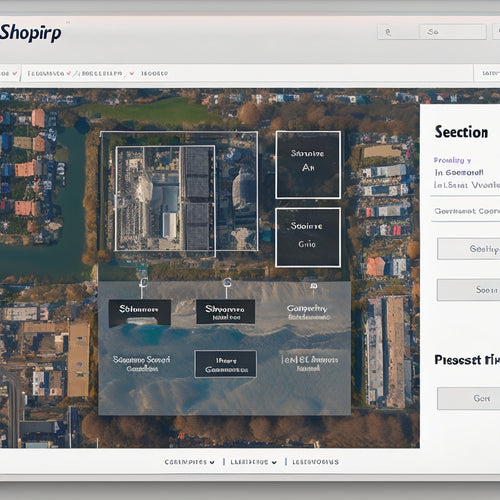
Optimize Online Course Pricing for Maximum Profit
Share
You've poured your heart into creating an exceptional online course, but without a well-crafted pricing strategy, you're leaving money on the table. To maximize profit, you need to understand your target audience's needs, pain points, and willingness to pay. Analyze your competitors' pricing strategies to identify gaps and opportunities. Calculate your production and delivery costs to set a minimum price, and determine your profit margin goals. Consider value-based pricing models, tiered pricing options, and limited-time offers to create urgency. By crunching the numbers and staying attuned to market trends, you can optimize your pricing for maximum profit - and that's just the starting point for opening up your course's full revenue potential.
Key Takeaways
• Conduct market research to identify trends, gaps, and opportunities, and analyze customer feedback to understand target audience needs and pain points.
• Calculate production and delivery costs accurately to determine the minimum price needed to break even and set profit margins accordingly.
• Tailor pricing strategy to accommodate different customer segments based on demographics and behavior, and understand unique needs, preferences, and willingness to pay.
• Utilize value-based pricing models by identifying unique selling propositions and emphasizing unique value to influence purchasing decisions and maximize profit.
• Regularly review and refine pricing strategy to stay updated on market trends, consumer behavior, and demand analysis, and adjust pricing psychology to optimize conversion rates.
Understanding Target Audience Needs
Analyzing your target audience's needs and pain points is necessary to creating an online course that resonates with them and ultimately drives sales. You must dig deep to understand what keeps them up at night, what they're struggling with, and what they're willing to pay to solve those problems.
Collecting customer feedback through surveys, social media, and online reviews is vital in this process. Additionally, conducting market research to identify trends, gaps, and opportunities in the market will give you a competitive edge.
Demographic analysis is also crucial in understanding your target audience's needs. By analyzing their age, income, occupation, and education level, you can tailor your course content and pricing to meet their specific needs.
Furthermore, understanding pricing psychology will help you determine the best price point that resonates with your audience. When you understand what drives their purchasing decisions, you can create a pricing strategy that speaks to their needs and ultimately drives sales.
Identifying Competitor Pricing Strategies
As you move forward with pricing your online course, you'll need to identify what your competitors are charging and how their pricing strategies align with their target audience needs.
By analyzing industry benchmarks, researching competitor offers, and identifying market gaps, you can develop a pricing strategy that sets your course apart.
This competitor analysis will help you pinpoint areas where you can optimize your pricing to stay competitive and maximize revenue.
Analyze Industry Benchmarks
Your online course's pricing strategy can't exist in a vacuum, so you need to identify how your competitors are pricing their courses to stay competitive. Analyzing industry benchmarks helps you understand the current market landscape and make informed decisions.
Conduct a pricing analysis to determine the average prices of similar courses in your niche. This will give you a baseline to work from.
Here are some key areas to focus on:
-
Research the prices of top-selling courses in your category to identify industry trends
-
Analyze the pricing structures of your direct competitors, including discounts, promotions, and bundle deals
-
Identify gaps in the market where you can differentiate your course and price it accordingly
-
Look at the price points of courses with similar production quality, length, and content to yours
-
Determine the price sensitivity of your target audience and how it affects their purchasing decisions
Research Competitor Offers
You'll now want to scrutinize your competitors' pricing strategies to identify patterns, gaps, and opportunities to differentiate your online course. Conduct a pricing comparison to understand how your competitors are positioning their courses in the market.
Analyze their pricing tiers, discounts, and promotions to identify areas where you can improve. Look for inconsistencies in their pricing structures and capitalize on them.
A thorough competitor analysis will reveal the strengths and weaknesses of your competitors' pricing strategies. Identify the most popular pricing models in your niche and assess how they align with your target audience's willingness to pay.
Note the price points at which your competitors are offering their courses and how they're justifying those prices. Are they emphasizing the value of their content, the expertise of their instructors, or the results their students can expect?
Identify Market Gaps
By dissecting your competitors' pricing strategies, you can uncover hidden market gaps that your online course can fill by offering a unique value proposition that resonates with your target audience. This involves identifying niche markets and analyzing customer behavior to understand what drives their purchasing decisions.
To do this, you need to conduct thorough market research, examining your competitors' pricing structures, promotions, and discounts. This will help you pinpoint areas where your course can differentiate itself and capitalize on untapped opportunities.
Here are some key areas to focus on:
-
Pricing psychology: Understand how your competitors use pricing to influence customer behavior and perception.
-
Identifying underserved segments: Look for niches that your competitors are neglecting or underserving, and tailor your course to meet their specific needs.
-
Competitor weaknesses: Analyze your competitors' pricing strategies to identify areas where they're vulnerable, and develop a strategy to exploit those weaknesses.
-
Value proposition: Develop a unique value proposition that sets your course apart from the competition and resonates with your target audience.
-
Gap analysis: Identify gaps in the market that your course can fill, and develop a pricing strategy that capitalizes on those opportunities.
Calculating Production and Delivery Costs
To accurately price your online course, you must first quantify the production and delivery costs, which encompass the expenses associated with creating and distributing your educational content. A thorough cost analysis will help you determine the minimum price you need to charge to break even. This will also give you a foundation for setting profit margins and pricing strategies.
| Cost Category | Estimated Cost |
| Content Creation | $5,000 |
| Platform and Hosting | $1,500 |
| Marketing and Advertising | $3,000 |
As you can see from the table above, production and delivery costs can add up quickly. By accurately calculating these costs, you can avoid underpricing your course and leaving money on the table.
On the other hand, overpricing can lead to low sales and revenue. By factoring in these costs, you can set a price that balances your budgeting needs with your customers' willingness to pay. This will enable you to maximize your profit margins and achieve your business goals.
Setting Profit Margin Goals
With your production and delivery costs quantified, it's now time to define your profit margin goals, which will serve as a benchmark for determining the best price for your online course. This critical step will help you strike a balance between profitability and customer affordability.
To set realistic and achievable profit margin goals, consider the following factors:
-
Conduct a profit margin analysis: Research your competitors' pricing strategies and calculate their profit margins to determine a suitable range for your course.
-
Identify your target audience: Understand their willingness to pay and adjust your profit margin goals accordingly.
-
Determine your revenue goals: Calculate how much revenue you need to generate to achieve your desired profit margin.
-
Assess market conditions: Consider factors like market saturation, competition, and seasonal fluctuations when setting your profit margin goals.
-
Prioritize your business objectives: Decide whether maximizing profit or increasing market share is more important to you, and adjust your profit margin goals accordingly.
Pricing for Different Customer Segments
You'll need to tailor your pricing strategy to accommodate different customer segments, each with unique needs, preferences, and willingness to pay. This is where customer segmentation comes into play. By dividing your target audience into distinct groups based on demographics, behavior, and other factors, you can create a pricing strategy that resonates with each segment.
For instance, students may be more price-sensitive than professionals, who are willing to pay a premium for advanced training. Similarly, entrepreneurs may prioritize flexibility and convenience over cost. By understanding these differences, you can adjust your pricing strategy to meet the specific needs of each segment.
This might involve offering tiered pricing, discounts, or bundles that appeal to specific groups.
Using Value-Based Pricing Models
Your online course's pricing strategy should hinge on the value it brings to customers, as this approach typically yields higher revenue and customer satisfaction than cost-plus or competitive-based pricing methods. By focusing on the value proposition of your course, you can create a pricing strategy that resonates with your target audience.
Here are some key considerations to keep in mind when using value-based pricing models:
-
Identify your unique selling proposition (USP): What sets your course apart from others in the market? Emphasize the benefits that only your course can provide.
-
Conduct customer surveys: Understand the perceived value of your course from your customers' perspective. This will help you determine the most suitable price point.
-
Analyze your competition: Research your competitors' pricing strategies, but don't let them dictate your prices. Instead, focus on differentiating your course and emphasizing its unique value.
-
Consider pricing psychology: Use pricing tactics like anchoring, scarcity, and bundles to influence customer purchasing decisions.
-
Test and refine: Continuously test your pricing strategy and gather feedback from customers to refine your approach and maximize revenue.
Offering Tiered Pricing Options
When you offer tiered pricing options, you're able to cater to a broader range of customers, each with their own unique needs and budget constraints.
By creating premium options, you can generate higher revenue from customers who are willing to pay more for advanced features or personalized support.
Meanwhile, lower-tier options guarantee that you're still accessible to price-sensitive customers who might otherwise be turned off by a single, higher price point.
Premium Options Available
Offering premium options with tiered pricing structures allows online course creators to tap into customers' willingness to pay more for added value, thereby increasing average revenue per user. By providing customized packages that cater to different segments of your audience, you can maximize revenue potential. This strategy is particularly effective when you offer exclusive benefits that justify the higher price points.
Here are some ways to create premium options that attract high-paying customers:
-
VIP access: Offer one-on-one coaching or priority support to premium customers.
-
Exclusive content: Provide bonus materials, such as advanced tutorials or expert interviews, that aren't available to standard customers.
-
Early access: Give premium customers early access to new course content or updates.
-
Lifetime updates: Offer lifetime access to course updates and new content for premium customers.
-
Personalized feedback: Provide personalized feedback and guidance to premium customers, helping them achieve their goals faster.
Pricing for Every Level
By structuring your online course pricing into tiered options, you can appeal to a broader range of customers, each with their unique budget and value expectations, thereby increasing your revenue potential.
This pricing tactic allows you to cater to different market segments, each with its own needs and willingness to pay.
For instance, you can offer a basic package with limited features at a lower price point, a mid-tier option with additional features, and a premium package with advanced features and personalized support.
Creating Urgency With Limited-Time Offers
Limited-time offers can be a powerful tool in your pricing optimization arsenal, as they create a sense of FOMO (fear of missing out) that motivates prospective students to enroll in your online course before the opportunity expires. By leveraging FOMO tactics and scarcity marketing, you can create a sense of urgency that drives sales.
Here are some strategies to contemplate:
-
Flash sales: Offer a limited-time discount to create a sense of urgency and encourage enrollments.
-
Countdown timers: Display a countdown timer on your website to show prospective students how much time is left to take advantage of a limited-time offer.
-
Exclusive access: Offer limited availability to a special group of students, such as early bird access or VIP membership.
-
Limited spots available: Create a sense of scarcity by limiting the number of spots available in your online course.
-
Deadline-driven promotions: Create promotions that are tied to specific deadlines, such as 'enroll by Friday to receive a bonus resource'.
Monitoring and Adjusting Pricing Strategies
As you've successfully created a sense of urgency with limited-time offers, now it's time to regularly review and refine your pricing strategy to keep it in peak condition and aligned with your online course's evolving goals and market conditions.
To optimize your pricing, you need to stay on top of market trends, consumer behavior, and demand analysis. Here's a framework to help you monitor and adjust your pricing strategy:
| Metric | Target | Action |
|---|---|---|
| Conversion rate | 20% increase | Adjust pricing psychology to emphasize value proposition |
| Customer acquisition cost | 15% decrease | Optimize demand analysis to identify price-sensitive segments |
| Average order value | 10% increase | Implement pricing elasticity strategies to maximize revenue |
| Customer lifetime value | 25% increase | Refine pricing strategy to target high-value customers |
| Net promoter score | 30% increase | Analyze consumer behavior to identify pricing pain points |
Frequently Asked Questions
Can I Price My Course Differently for Loyal Customers or Repeat Buyers?
You can create a customer segmentation strategy, offering personalized discounts to loyal customers or repeat buyers, rewarding their loyalty with exclusive pricing, increasing their lifetime value and boosting your revenue streams.
How Do I Handle Pricing for Courses With Varying Levels of Complexity?
You're about to crack the code: as you navigate courses with varying complexity levels, you'll need to develop pricing strategies that reflect the value proposition of each, factoring in production costs, expertise, and learner outcomes.
What if My Course Has a High Perceived Value but Low Production Costs?
When your course boasts high perceived value but low production costs, you're sitting on a pricing goldmine. You're free to set a premium price, leveraging value perception while keeping costs in check, maximizing your profit margin.
Should I Offer Discounts for Bulk Purchases or Corporate Licenses?
As you navigate the pricing landscape, consider offering group discounts or special promotions for bulk purchases, akin to casting a wide net, to reel in corporate clients and student scholarships, while maintaining tiered pricing that reflects your course's value.
Can I Use Pricing to Incentivize Students to Complete the Course Quickly?
You can leverage time-based incentives to boost completion rates by offering tiered pricing discounts for students who finish the course within a set timeframe, thereby increasing student engagement and driving revenue.
Related Posts
-

Adding Sitemap to Your Shopify Store: A Complete Guide
This article aims to provide a comprehensive guide on the process of adding a sitemap to a Shopify store. A sitemap ...
-

Images Shopify Apps Play a Vital Role in Improving Site Visuals and Loading Speeds
This article examines the significance of Shopify apps for image optimization in enhancing site visuals and loading ...
-

Shopify: The Ultimate E-commerce Solution
Shopify is a highly regarded subscription-based software designed for setting up and managing online stores, as well...


